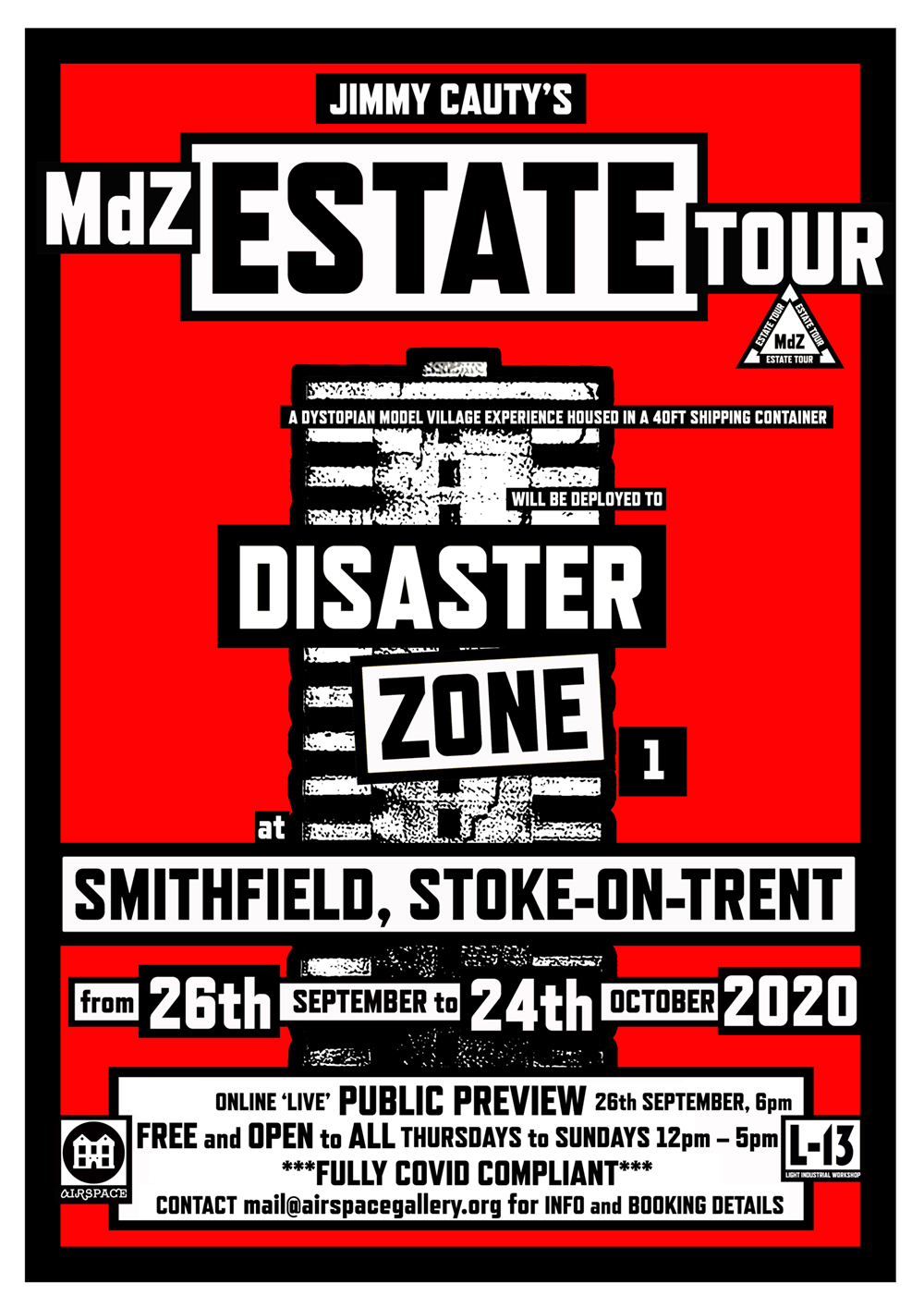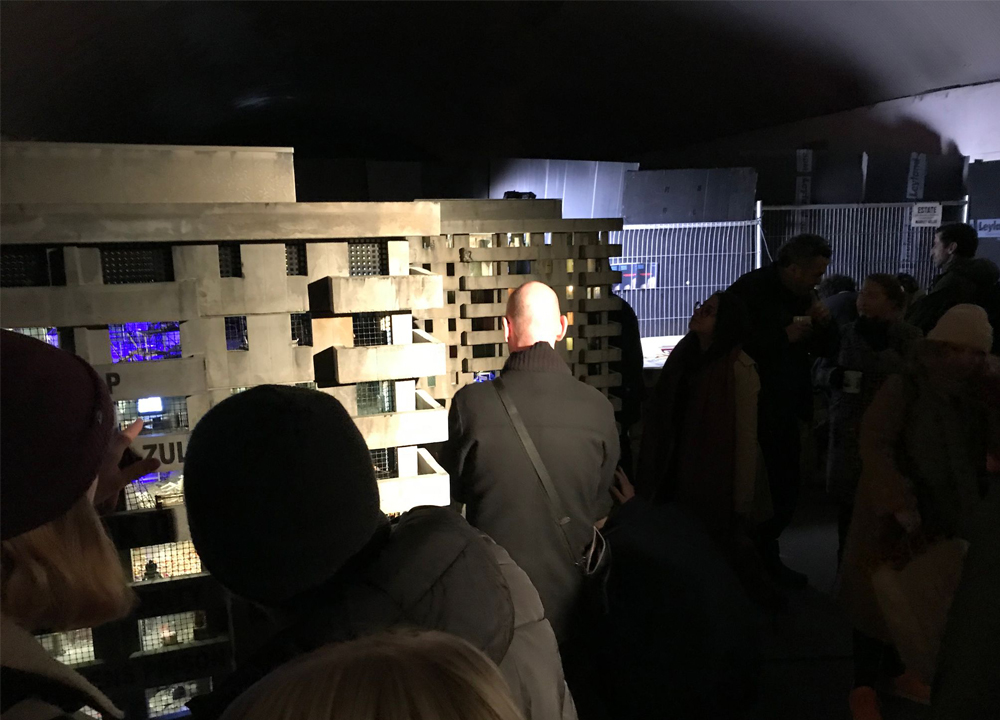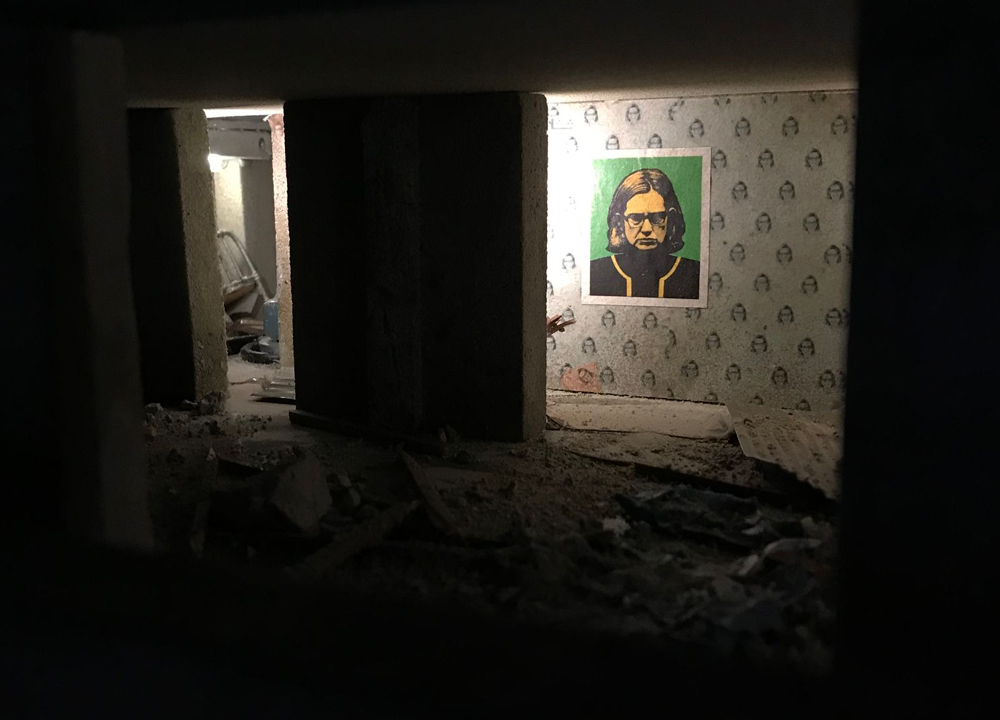ESTATE
JIMMY CAUTY
26 SEPTEMBER – 24 OCTOBER, 2020It is in many ways a continuation of the ADP Riot Tour.
Each tower block is 17 floors high (approx. 2 metres) with meticulously crafted derelict interiors - some with lights, toilets and tiny TVs playing looped public information broadcasts. One tower block is dedicated to residential and light industrial Live Work Die units, another is a children’s prison, the third a high-rise residential care home, and the last appears to have functioned as a pagan religious centre. They are all empty and no one knows what happened to the inhabitants.
The container has three operating modes: LOCKDOWN, STANDBY and FULL ENGLISH
It will always be (where possible) invigilated by young people known as the CHILDREN OF THE AFTERMATH
EXCLUSIVE TRAILERS
THE END OF THE WORLD PARTY
25/10/20 4pm
A final last lament for ESTATE and all estates everywhere. LIVE on INSTAGRAM. Everyone invited but PLEASE DON'T COME.
A Map of Alternative Monuments
by Rebecca Davies

To download your own HiRes version - click HERE
TOUR SCHEDULE
ESTATE #TPD446 has been a work in progress since 2018. It is now at the end of the build stage and, following beta testing on 5th August 2020 at a secret location in London, the work is now ready for its world premiere on the Smithfield site in the City Centre of in Stoke- on-Trent, in collaboration with Airspace Gallery.
From here, ESTATE will embark on the next stage of its world tour. At each stage of the tour the local hosts will be encouraged to take matters into their own hands and develop their own programme of events in response to ESTATE #TPD446 in a way that is pertinent and meaningful to them.
TOWARDS OUR NEW ARCHITECTURE
Written by Anna Francis and Rebecca Davies, lead artists of The Portland Inn Project – community led change for a neighbourhood in Stoke on Trent.
As I lay on the bed this morning, feeding my daughter, I was planning a new architecture. It was an architecture of mothers, daughters, sisters, aunties.
We wanted to talk about soft things; flesh, muscle, the curve of a stomach, the ligaments and tendons that hold things together.
It doesn’t fit into the Masterplan, They told us.
They already had a plan for the town – it was made of brick, steel girder, concrete and glass.
There will be no Masterplan here, the women said.
The women met and we talked about the moments in between; time alone, in the bath, painted nails and children kept off school. Houses became tombs, and windows overlooked barren, barbarous streets. Stop talking about the children we said, this is our moment.
But when it came to it, planning what would happen in those streets, One woman mentioned that the hill was perfect for sledging and that the window should overlook the hill, so she could stand in the kitchen and watch the children sledging down, while she had a moment to herself.
What do you want to do in that moment?
The other women asked.
Nothing, she said.
How do we do this? We asked each other – having never planned a town before.
We will become a coven of witches, and hold a séance. We will call together the designers and the decision makers to put forward the best of their plans and we will create something new.
THE SÉANCE
Persons
The Women
Le Corbusier
Aneurin Bevan
Jane Jacobs
Alison and Peter Smithson
Act One. Scene 1
One night when the moon was full and high, the women came together, in a house on a street, in the neighbourhood.
The Women. We summon the spirits of housing development, architecture, policy and planning!
The Women. Welcome Le!!!
Le Corbusier. My name is Charles-Édouard.
The Women. Nye Bevan! You made it!
Aneurin Bevan. Wouldn’t miss this for the world.
The Women. Jane – thank you for coming.
Jane Jacobs. Pleasure, women.
The Women. Alison and Peter!
The Smithsons. Hello!
The Women. We have brought you here to request your visions for our neighbourhood. There has been a palpable shift in how we feel about the places we live, work and play; there is a need for something different. We have felt trapped in our homes and crave togetherness.
They have tasked us with rewriting the plan and we call on you and your ideas to help us draw this plan to represent us, our needs and our neighbourhood.
Le Corbusier. I can help you with that – Firstly I suggest standardised dwellings, equal sized, beautifully designed spaces for living in. Functional. A rejection of the chaos of the street!
The Women. You are putting forward a sterile vision for our neighbourhood. We are not robots. We would like to ask; do you have children? Do you understand that you cannot shut chaos out by closing the front door? And how will these dwellings age as we get older and our children grow up? Everything in your plan looks the same – like a spreadsheet.
Aneurin Bevan. And this is exactly what I didn’t want for my vision for social housing. Better to have different shaped spaces, different architectures – social house beside town house, green spaces – a mix of people from society, a range of classes together is the ideal.
The Smithsons. We look at the whole habitat – like Bevan proposed. Thinking about all the elements of the neighbourhood being a part of the ecology. From belonging comes the enriching sense of neighbourliness. We believe we are putting into practice those ideals that Nye held high.
Aneurin Bevan. We have been the dreamers. We have been the sufferers. Now we are the builders.
The Smithsons. Our aim is not to theorise but to build - only through construction can a utopia of the present be realised.
The Women. But we are not just designing for the present. Our design needs to have space to accommodate the will of the children; progress. We believe that architecture should be about designing and creating SPACE – use for now, but also use for the future. Is there room in the plan for the next generation?
Jane Jacobs. The next generation needs to be a part of the decision making and the design. Cities have the capability of providing something for everybody, only because, and only when, they are created by everybody.
Le Corbusier. I have spoken about dwellings, but I am not just talking about designing a building. My proposal is for architecture as an economic and political tool that can be used to improve the world through the iconic buildings we design and through MY… sorry! OUR plan.
The Women. Have you designed something that is so immoveable that the only option is to knock it down if it doesn’t work? We don’t want a monument to ourselves - we want to build space for everyone.
Le Corbusier. Ah but I am designing a utopia!
Jane Jacobs. Or a Dystopia!?
The Women. Would YOU live here Le?! We want to move away from polarised words like ‘utopia’ and ‘dystopia’. We have lived through the failures of your utopian dream. We talk about ‘ideals’ only because we have been living in an environment that is not ideal – what has been produced is sub-standard and often dangerous.
Is it so much to ask for representation? Care? That design be collaborative and sustain a range of futures? We have appreciated hearing your voices, because it has made us recognise the power of our own.
This is not an architecture of bricks and mortar – for us, architecture is the space between us and WE are the architects of our own lives.
(BLACKOUT)
Act One. Scene 2
The Women are preparing for an event in the newly renovated Portland Inn.
(CURTAIN)
ABOUT JIMMY CAUTY
As a teenager Cauty drew the intricate multi-million selling Lord of the Rings poster for British retailer Athena. With Bill Drummond as The KLF and the Justified Ancients of Mu Mu, Cauty co-wrote and produced a string of global top ten hits.
As The K-Foundation, Cauty and Drummond staged a series of seminal actions including the 1994 K Foundation Art Award for Worst Artist of the Year and the K Foundation Burn A Million Quid.
From experimental sonic weapons (the Advanced Acoustic Armaments), to anti-war postage stamps (Stamps of Mass Destruction), and model making (Riot In A Jam Jar and the Aftermath Dislocation Principle) Cauty’s work combines dissent, cultural subversion and gleeful level of high humour. His roguish and voluble approach has earned him a cult following for work that remains radical, responsive and darkly comical. He produces work that draws on and responds to contemporary culture, sampling it and selling it back as recoded realities.
In 2013 Cauty completed The Aftermath Dislocation Principle (ADP), a vast 1:87 scale-model landscape (equivalent to 1 sq mile in miniature) which has been completely looted, destroyed, burnt and is devoid of life apart from 3000 or so model police that attend this apocalyptic aftermath. In 2015 the ADP was shown at Banksy’s Dismaland in Weston Super Mare. The following year the ADP was re-configured and housed in a 40ft shipping container with industrial viewing ports built into the sides, and despatched on a pilgrimage to over 35 sites of historic rioting and public dissent in the UK: The ADP Riot Tour. By the end of the tour the ADP was viewed by more than 1 million people.
The ADP now tours sites of historic rioting around the world and is currently in Tasmania, but soon to head for The Netherlands.
The Children of the Aftermath
During the ADP Riot Tour it was discovered that children were the most enthusiastic and articulate ambassadors for the work. So, for the World Riot Tour, it was decided that young people known as The Children of the Aftermath would be the principle invigilators of the work to help guide visitors and answer the difficult questions the artist and organisers would try to avoid.
Funding and partner support from:















